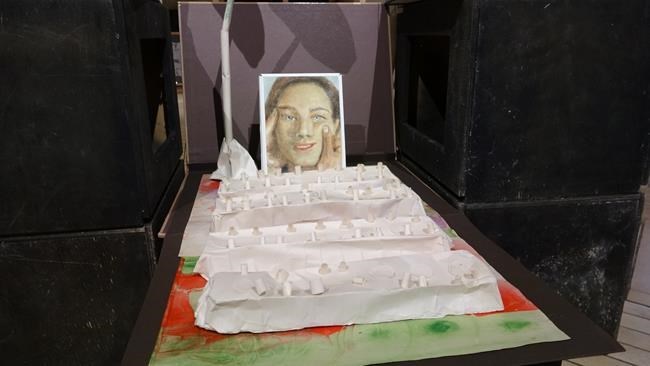KYIV, Ukraine — At first glance, the space looks like any other trendy gallery in a western country: faded walls, a stylish café where regulars chat quietly, all in a neighbourhood that wouldn't look that out of place in Montreal.
But hanging on the walls beside peeling paint and cracked plaster, small images are vaguely reminiscent of photos and internet memes that have been circulating since the beginning of the war in Ukraine.
Draw a little closer, and certain scenes are clearly recognizable after nine months of war — smouldering ruins, downed helicopters, exhausted soldiers dozing off, a Russian pilot in a bright orange suit on his knees after he was just captured.
Welcome to The Naked Room gallery, the hot spot for modern art in Kyiv.
The current anguish of Kyiv's residents, who are living in fear of another Russian bombardment, would barely be evident in this tranquil spot, if not for the works of art that document the country's horror in their own way. It is the artists' response when destruction and suffering are everywhere, and museums in areas occupied by the Russians have been destroyed or pillaged.
"If we will not make art today, maybe we will not have it tomorrow," gallery administrator Pavel Tretyakov told The Canadian Press through an interpreter. "Because we have missiles, we have rockets, we have all these things shelling us. Maybe tomorrow will be too late, so we should do it today."
Even while many artists in Kyiv are struggling, "we have even more art now than before" in Kyiv, he said. Creators, many of whom contributed to the country's defence as volunteers, stretcher bearers and even soldiers at the beginning of the war, have now mostly returned to their studios.
Olya Balashova, director of the non-governmental organization Museum of Contemporary Art — which is pushing for the creation of a true contemporary art museum in Kyiv — said a group visual arts project has been documenting the Russian invasion daily since it began on Feb. 24. The Naked Room gallery has become the headquarters for the project, the Emergency Art Fund, which follows some 200 artists and their works published on social media.
"It's a kind of emotional landscape of each day" that becomes part of the collective memory, Balashova said. "It's a very important tool that helps us to understand ourselves, helps a kind of social healing." Speaking to The Canadian Press in a gallery surrounded by dozens of works on paper, enamel and even placemats, she said the project will continue "until the victory of Ukraine."
On one wall is a troubling series entitled "Blitzkrieg," a German term from the Second World War that refers to a quick, surprise attack intended to level the opponent — the goal of the Russian invasion that has now dragged into its ninth month.
The work by Serhii Lykhovid makes use of photos that have become well known during the war, reproducing them on hard enamel in exaggerated, bright colours that look like tiles. The artist in his own way immortalizes fleeting images drawn from social media, Balashova explained.
On another wall, a large horizontal acrylic painting on cardboard, unframed and warped, seems to be floating. It depicts a calm, sparkling sea under a blue sky, and what seems to be the back of a woman bathing up to her knees in the distance. A Ukrainian will recognize it as the shallow Sea of Azov. Balashova says the artist, Karyna Synytsia, is able to evoke and reconstruct memories of her childhood, despite the war.
Many of the works in the gallery share a theme of memories being rebuilt, but in an incomplete, flawed way, because the brutality of war has created a detachment from daily routines, from the past, from home.
On the facing wall a small rectangular work draws the eye, looking almost like a board of mounted insects. But in fact they are carefully arranged pieces of shrapnel and fragments gathered in Irpin, outside Kyiv, known as a hero city of Ukraine. It was there that Russian troops were turned back after fierce battles. The work by Anastasiia Tsylenko is titled "Window."
With a war raging, Ukrainian artists cannot currently count on art lovers and collectors in their country for financial support, Balashova acknowledged. Foreign patrons, however, are discovering Ukrainian art and have been generous. But there is a concern among artists and curators to ensure that the bulk of the artwork doesn't leave the country.
"This is not a good time for buying art now, and we all wait for the victory," Tretyakov said. "After our victory I believe everything will come back and we have an explosion of Ukrainian art and Ukrainian culture .... When we win, everything will thrive more."
This report by The Canadian Press was first published Dec. 1, 2022.
— Patrice Bergeron is a Quebec-based journalist with The Canadian Press. In addition to two decades of political and general news experience, he was a CP war correspondent in Afghanistan in 2009.
Patrice Bergeron, The Canadian Press



